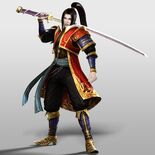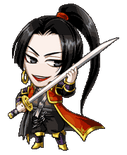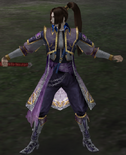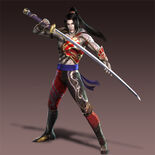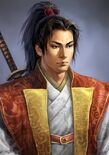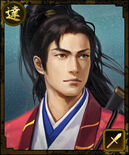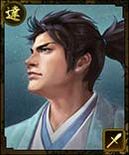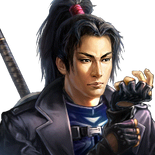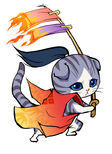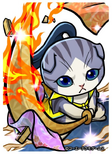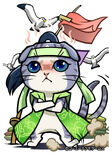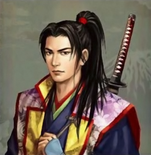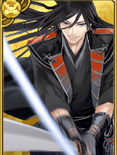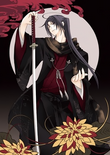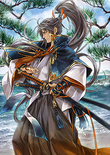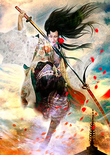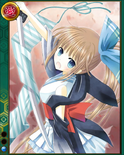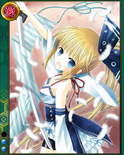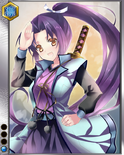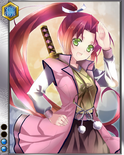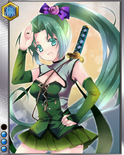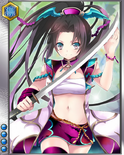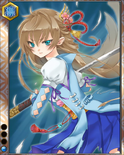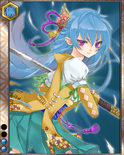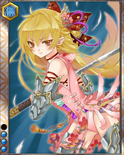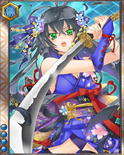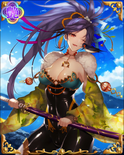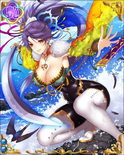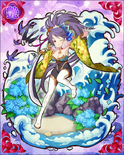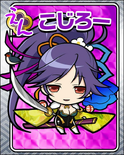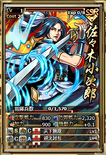| Kojirō Sasaki | |
| Clan(s)/Alliance(s): | Sasaki Hosokawa Eastern Army |
|---|---|
| Age: | 27
|
| Height: | 196 cm (6'5")
|
| Weapon(s): | Nodachi (2) Nodachi and two flying broadswords (2XL, 4) |
| Heirloom: | Kanemaki's Teachings
|
| Moveset Type: | Normal
|
| Playable Debut: | Samurai Warriors 2: Empires |
| Real name: | Sasaki Kojirō
|
| Japanese name: | 佐々木 小次郎
|
| Born: | 1575
|
| Died: | May 13, 1612
|
| Force: | |
| Stage: | |
| Character Type: | |
| Sacred Treasure: | Dáinsleif
|
Kojirō Sasaki is a swordsman who is thought to have existed during the early Edo period. Not much is known about his true identity or history, an enigma with scholars to this day. In contemporary fiction, he is immortalized as Musashi's greatest rival. His final duel at Ganryūjima remains his most famous exploit.
He is first introduced in the Samurai Warriors series in its second entry as a unique NPC and bodyguard. Like Katsuie, he is a playable character with a mixed moveset in its Empires adaptation. He gains a new moveset, weapons and story by Samurai Warriors 2: Xtreme Legends. He is voted thirty-ninth of the cast in the Samurai Warriors 4 poll and nineteenth place in the first Sengoku Musou Shoot character popularity poll.
The Nobunaga no Yabou 201X poll for 4-star officers puts him in thirty-seventh place.
Role in Games[]
"This guy is pretty disturbed. How did he end up on our side?"
- ~~Meng Huo; Warriors Orochi 3
Samurai Warriors[]
In Samurai Warriors 2, Kojirō appears as reinforcements for the Eastern army at the Battle of Kuzegawa. He is one of the generals who guards their escape point. During Ginchiyo's story mode, he reinforces Yoshihiro and traps Sakon at Shōryuji. He also appears in various other scenarios, mostly limited to dream stages. In Musashi's story mode, he acts as his rival's foil and taunts him at any given opportunity. He is killed in their duel at Ganryujima. If he is impressed during Musashi's dream mode, he will appear as the stage's last challenger. When he's defeated, he dubs his rival as the land's greatest warrior with his dying breath. His recruitment mission in Survival Mode is an open call for a sword instructor, an opportunity he will take if the objectives are completed successfully.
In the Swordsman scenario of Samurai Warriors: Katana, Kojirō initially confuses the protagonist for Musashi during a pirate raid at Ganryūjima. Realizing his mistake, he demands a challenge anyway upon hearing of the player's reputation as a master swordsman. Although he fails to meet up with his intended opponent as a result, the Unification scenario has the two rivals find a common enemy in the protagonist for disrupting one of their duels. Both men challenge the interloper at the same time only to lose unexpectedly.
His story in Samurai Warriors 2: Xtreme Legends explains how the two swordsmen meet one another. Kojirō, after witnessing villagers being slaughtered by pirates, decides to satisfy his boredom by defeating the brigands. During his unintentional rescue, Musashi appears to help him. At the battle's conclusion, Kojirō sees Musashi as his greatest opponent and becomes obsessed with showing his rival a "truly beautiful" death.
After the other swordsman flees, Kojirō's talents were scouted by the Tokugawa clan. He fights for the Eastern army at Kuzegawa and Sekigahara. After scoring the victory at Sekigahara, the Tokugawa clan hire him to frame Hideyori for scheming to take Ieyasu's life in Kyoto. Unexpectedly, an assassination was actually planned and Kojirō is ordered to kill Hideyori instead. Yukimura, Kiyomasa, and Musashi help the young heir safely escape. More interested in dueling his rival, Kojirō's focus shifts to Musashi and he beats him. Curious to know how a sword can move people, he gives Musashi a year to hone his craft. Kojirō later duels Musashi at Ganryujima and miraculously survives his defeat. He then joins the Tokugawa ranks to destroy Osaka Castle. Once the Tokugawa army claims victory, the two swordsmen have one last match together. In his ending, Kojirō is thrilled to finally achieve his goal but is simultaneously stricken at losing his greatest rival.
In his dream mode, Kojirō and Musashi work together to defeat many of the land's greatest swordsmen at Komaki-Nagakute. They additionally compete with one another to see who can score the most fame.
Kojirō's lone appearance in Samurai Warriors 4's Story Mode is at Ishigakibaru in the Chugoku chapter. He joins the troops in Kyushu for a chance to face his rival in combat and retreats upon his defeat. During the Kyushu chapter's equivalent of the same stage (Yanagawa), Kojirō appears as unexpected ally reinforcements. In this game's Chronicle Mode, the player character can choose to either assist or defeat Kojirō at Ganryujima or face him in a competition against swordsmen.
During his personal events, Kojirō insists the person underneath his makeup is dead and avoids talking about it to the player character. After Kojirō cleaves a boulder in twain at the player character's request, an observing Munenori recognizes the swordsman's technique and identifies him as a young successor to a clan in Kyūshū who was once presumed dead. Kojirō later elaborates that a samurai family once existed in Kyūshū yet was completely massacred when they lost in their defiance to the land's unifier. He is aware that his clan's landless retainers and the Emperor wish to raise arms to revive his family's territory, but Kojirō is tired of war. He assumed his new lifestyle to forget his past life and to stay true to his dedication for his sword training.
Kojirō rejoices when Musashi later agrees to duel him at Ganryūjima and tells his traveling companion the good news before he leaves. The player character can either offer to run away with him to the southern islands afterwards or congratulate him. Kojirō brightens at the former option since he is aware that his family's followers are closing in on their location. He promises to share a happy future with the player character forever escaping them, feeling that he may someday show him/her the real him. Either option leads to his death at Ganryujima. Rumors say that he was killed by Musashi's disciples yet the true reasons for his death are shrouded in mystery.
Warriors Orochi[]
In Warriors Orochi 2, Kojirō plays a small role in the Samurai story mode. He was on Da Ji's side but after he was defeated by Xu Huang and Musashi, he decides to fight alongside them. In his dream mode, he joins a mock battle with Taishi Ci and Wei Yan. In it he confuses Musashi by helping the peasants. He also appears as an enemy in various dream modes, such as the Itsukushima dream mode where he teams up with Kotarō to try and kill Liu Bei, and the dream mode in Rescue at Nan Zhong to harm peasants.
Having lost sight of Musashi in the dimensional realm, Kojirō wanders the land for his rival in Warriors Orochi 3. He happens to be in Nanzhong when it is invaded by a large serpent army battalion. As he satisfies his bloodlust, he and Zhang He share an understanding with one another regarding the beauty in battle. When the battle ends, Kojirō joins the coalition as an excuse to properly sate his murderous desires. If he goes to Dongkou with Kai and company, he will issue that no one should be allowed to murder Musashi but himself.
His conversations with Musashi in the camp has a sub story of Musashi finding and taking care of an injured bear cub. Kojiro states he does not understand why Musashi would help a creature, when he himself is a swordsman, since Kojiro considers all swordsmen to be killers at heart, and that he should have just killed it to put it out of its misery. Musashi, over time, explains that being a swordsman comes second to being human, and that helping the poor creature is the more humane thing to do, than just outright killing it. Eventually the Bear is found missing, and when Musashi confronts Kojirō about it, he claims he set the bear free by cutting its chains, because the animal had reached full health.
He also appears in the downloadable scenario "Phantoms of Nanzhong", where he assists Kanbei Kuroda and Zhou Tai in rescuing the wrongly assumed phantom Guo Huai from Meng Huo's army.
Kojirō was in the middle of a duel with Musashi when they were found at Ji Province, engaged Dong Zhuo's army during Warriors Orochi 4. Briefly mistaking Lu Xun and Zhu Ran to be part of the enemy, the two samurai attack them, but the misunderstanding is soon cleared up. The four later join together and compete at the same time to eliminate Dong Zhuo after.
After the battle's conclusion, Kojirō joins the Rebel army alongside his rival.
Character Information[]
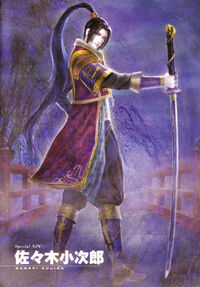
Kojirō's artwork in Samurai Warriors 2.
Development[]
Designers remark that Kojirō was developed to be the "cool and handsome villain" to contrast Musashi. The serpent design on his long sword is meant to invoke an insidious and demonic presence for him. His designer was surprised to see his 3D model's ghastly white skin complexion.
Personality[]
Kojirō appears as a sadistic narcissist, who loves to kill and prove his strength with his sword. Most of his appearances have him talk about him enjoying the opportunity to kill in a "beautiful fashion", as well as doing it to free the souls of those he deems "pitiful". Though he is easily angered by the thought of someone better than him, he becomes intrigued by Musashi's skill and is motivated to outdo him and prove himself as absolute best swordsman. Kojirō also openly despises false displays of strength, initially deeming those who are strong to merely be parasites instead of entities with actual strength; he even spites those who are not even on the same level as him when it comes to besting them in combat no matter their personality or intentions. This viewpoint is somewhat altered as soon as he meets Musashi for the first time.
However, in the fourth installment's chronicle mode, Kojirō reveals a side he often keeps under wraps, twisted by the deaths of his previous family that turned him into the man he was today. Kojirō openly admits he wants nothing more than to forget his past, and chooses to live by his sword's way (to the point where he finds rebellion for the sake of his family a moot option). He also hides a slight trace of sadness within as shown during his opening cutscene in the second installment's Xtreme Legends expansion, where he briefly sheds a tear just after saving a mother an her child.
Aside from obsessing over Musashi, he offers special praise to Zhang Jiao, Zhang Liao, Zhang He, Meng Huo, Zhurong, and Wei Yan in the Warriors Orochi series. He shares the interest of finding beauty in battle with Zhang He. Zhang He idolizes Kojirō as a fighter matching his beauty and wishes to learn from him. The two eventually form a bond akin to brothers to the point that Kojirō can't bring himself to kill Zhang He. His associations with the Nanman leaders are awkward for him at first, since the Nanman treat him warmly as family. Although their generosity is alien to him, he gradually welcomes the prospect of living amongst them.
Another unique trait is that unlike most portrayals of Kojirō, the Warriors version speaks in a more humble tone despite his sinister personality, as he often uses the pronoun "boku" when referring to himself.
Character Symbolism[]
Kojirō's is symbolized by the kanji for "sword" (剣) and "swallow" (燕) and by camellia petals for his Samurai Warriors counterpart; the second kanji nods to one of his most famous traits being his allegedly famed technique, the Tsubame Gaeshi, known to be a slashing technique that resembles a swallow in flight, observed from Iwakuni's Kintai Bridge. His Warriors character names the move randomly during his attacks in reference to its endless interpretations in folklore and fiction (along with its name being adapted into a jūdō technique and a mahjong hand in the present day). Adaptations of Kojirō's life claimed that his drive to perfect this technique was to be able to with ease, cut down swallows that flew too fast for most sword slashes to reach. Kojirō attempts a Tsubame Gaeshi on Musashi before being slain in the pre-rendered cutscene of their duel in Samurai Warriors 2, though in the English versions, Kojirō instead yells, "Now you die!", when performing it.
Kojirō's fourth weapon for his Empires appearance is named after his swordsman's name, Ganryū. The original name implies it's forged from diamond.
Kojirō's titles in Samurai Warriors 2: Xtreme Legends are "Stick Wielder", "Painted Clown", "Aesthete", "Flashing Blade", "Mortiferous Grace", "Netherworld Swordsman", and "Musashi's Conqueror".
His first two blades for his playable appearance are named after twilight. The first sword is literally named "Child of Darkness" while his second sword describes a gust of wind blowing from the shadows. His signature Drying Pole (物干竿, Monohoshizao) is actually his third weapon in the Asian ports.
The Asian name for his fourth weapon is named after Tajimamori, a person found within Japanese mythology. On the order of the Emperor Suinin, Tajimamori was ordered to search for Tokijiku-no-Kagu-no-Konomi. Crossing to the great unknown lands of Tokoyo-no-Kuni, Tajimamori spent ten years on his journey. He successfully found and collected two branches and one had fruit. By the time he returned to Nakatsu Kuni, the emperor had long passed away. He presented one branch to the empress and the other at Emperor Suinin's grave. Tajimamori spent his remaining days feeling hollow and depressed, weeping every day until he died shortly after his return home. The fruit he returned with eventually became a snack for the gods and were named after him.
Kamimusubi forms the namesake for Kojirō's fifth weapon. The Japanese god is one of the Three Pillars within Japanese mythology and existed before Izanami or Izanagi. Kamimusubi is said to have been a "sole god", or a being that was created without the need of a male or female entity. Neither a female or male, the god is one of creation who gains its power from the shadows. With the ability to create anything from nothing, Kamimusubi is sometimes romanticized as a goddess of Izumo. According to their legends, she rebuilt the land from nothing and is a mother-like entity. When joined with Takamimusubi, they represent masculine and feminine traits.
Voice Actors[]
- Maxime Mensah - Samurai Warriors 2 (English)
- Antoine Yared - Samurai Warriors 2: Xtreme Legends (English)
- Johnny Yong Bosch - Samurai Warriors: Katana (English-uncredited)
- Brian Beacock - Warriors Orochi 2 (English-uncredited)
- Yūji Ueda - Samurai Warriors and Warriors Orochi series (Japanese)
- Kouji Takahashi - Nioh
- Hiroki Takahashi - Iza, Shutsujin! Koi Ikusa
Live Action Performers[]
- Shinichi Kobayash - Makai ~Hoshi to Umi no Hangeki~, Makai ~Fukkatsu to Yabou Revival and Vision~
Quotes[]
- See also: Kojirō Sasaki/Quotes
- "...I smell strength. Ah, now here's someone worth chopping to pieces."
- "Look out! The spirit of a dead woman walks among the enemy!"
- "Are you trying to insult me, or are you just stupid?"
- ~~Nagamasa and Kojirō; Samurai Warriors 2: Empires
- "You vile creature. War should not be waged needlessly."
- "But I am an aesthete, my dear. We must not talk of the practicalities. Nothing I do is needless - the beauty of war is its own justification."
- ~~Ina and Kojirō; Samurai Warriors 2: Xtreme Legends
- "I sense nothing but madness in your blade."
- "You truly flatter me. I thank you."
- "Well, I didn't mean for you to take it that way..."
- "(chuckles) Ah, I feel so good right now I just have to chop you up. Now, come to me."
- "(laughs) I may be old, but don't think I'll be an easy win."
- "Oh, I won't. Because I'm facing you, I'll make you my finest kill."
- ~~Nobutsuna Kamiizumi and Kojirō; 100man-nin no Sengoku Musou
- "Now, why are you putting on that white paint?"
- "My reasons for this makeup aside... Katsuie, you don't put on makeup? I mean, since a warrior could die on the battlefield at any time, putting on your funeral makeup now seems like a good idea."
- ~~Katsuie and Kojirō; Samurai Warriors Chronicles 3
- "It is not too late! Repent, and you will be saved."
- "It's you who'll be saved - from this nasty world, by me ending your life."
- ~~Zhang Jiao and Kojirō; Warriors Orochi 2
- "If you want to be surrounded in beauty until your dying breath, I could cut you down in a most elegant manner."
- "You would even consider the manner of my death? You are a great seeker of beauty!"
- "Then I will not kill you. I cannot even bring myself to pity you."
- ~~Kojirō and Zhang He; Warriors Orochi 3
- "I love sitting around the fire with you, just the two of us."
- "So do I. As long as no one's surrounding us in turn, of course."
- "Of course. ...You never ask me anything, do you, Lu Xun? About my past, or anything like that...?"
- "If you want me to ask you, I will. It's just... it never looked like you did. No matter what may be in your past, it will have no effect on our friendship. We will still fight together, talk together, and laugh together. Isn't that enough?"
- "...Hehe, you're right. You really shine bright like no one else I've ever met. And if it's just for a while, I think it might be all right for me to allow myself to stand by that dazzling flame..."
- ~~Kojirō and Lu Xun; Warriors Orochi 4
Gameplay[]
- See also: Kojirō Sasaki/Movesets
Samurai Warriors 2: Xtreme Legends[]
| Keys: |
While not playable, Kojiro uses the NPC Sword moveset in Samurai Warriors 2 and 2 Empires.
Ground Moveset[]
 : Throws a broadsword forwards and downward as he steps forward that eventually flies back before disappearing. Can break guards.
: Throws a broadsword forwards and downward as he steps forward that eventually flies back before disappearing. Can break guards. ,
,  : An upward drilling-stab lift with a broadsword that launches the enemy up.
: An upward drilling-stab lift with a broadsword that launches the enemy up. ,
,  ,
,  : Back-flips and while upside down at his peak, throws a broadsword forwards that stuns targets.
: Back-flips and while upside down at his peak, throws a broadsword forwards that stuns targets. ,
,  ,
,  ,
,  : Slashes horizontally inwards-forward with both his broadswords via a pincer-strike motion.
: Slashes horizontally inwards-forward with both his broadswords via a pincer-strike motion. ,
,  ,
,  ,
,  ,
,  : Spins both broadswords around him that launch enemies upward.
: Spins both broadswords around him that launch enemies upward. ,
,  ,
,  ,
,  ,
,  ,
,  : Sends both broadswords spinning out moving forward in front of him like a windmill that stuns enemies.
: Sends both broadswords spinning out moving forward in front of him like a windmill that stuns enemies. ,
,  ,
,  ,
,  ,
,  ,
,  ,
,  : Grabs an enemy in front of him with his free hand, and then rips them from inside out, flinging them away thus causing ripples of attacks. Drains a notable amount of HP from his target.
: Grabs an enemy in front of him with his free hand, and then rips them from inside out, flinging them away thus causing ripples of attacks. Drains a notable amount of HP from his target. ,
,  ,
,  ,
,  ,
,  ,
,  ,
,  ,
,  : Generates a field that slows time in front of him before slicing-left to his front with both broadswords stacked upon each other in an orbit. Has a slight dead-zone at point-blank range all around him for the broadsword hitboxes.
: Generates a field that slows time in front of him before slicing-left to his front with both broadswords stacked upon each other in an orbit. Has a slight dead-zone at point-blank range all around him for the broadsword hitboxes. ,
,  ,
,  ,
,  ,
,  ,
,  ,
,  ,
,  ,
,  (Xtreme Legends only): A possible flanking-variation of his Tsubame Gaeshi. Disappears and then does a spinning horizontal slash with his nodachi to his left (in reverse-grip) at the back of any targets in front of him.
(Xtreme Legends only): A possible flanking-variation of his Tsubame Gaeshi. Disappears and then does a spinning horizontal slash with his nodachi to his left (in reverse-grip) at the back of any targets in front of him. : Repeatedly throws multiple horizontal Tsubame Gaeshi (as he says at the start of the musou) in front him from left to right, generating blue cutting waves as he does. Kojirō stands in one place while doing this. In his level three version, the waves will be projected at a quicker rate and energy waves will accompany him.
: Repeatedly throws multiple horizontal Tsubame Gaeshi (as he says at the start of the musou) in front him from left to right, generating blue cutting waves as he does. Kojirō stands in one place while doing this. In his level three version, the waves will be projected at a quicker rate and energy waves will accompany him.
 ,
,  ,
,  ,
,  ,
,  ,
,  ,
,  ,
,  ,
,  ,
,  ,
,  ,
,  : An outward flicking slash, inward cut that causes him to turn his back, two turning two-handed slashes to the right, one-handed swing to upper left, swing to the horizontal right, then to the left, then four fencing stabs (that shoot out energy darts) with a finishing two-handed slash to the right.
: An outward flicking slash, inward cut that causes him to turn his back, two turning two-handed slashes to the right, one-handed swing to upper left, swing to the horizontal right, then to the left, then four fencing stabs (that shoot out energy darts) with a finishing two-handed slash to the right. ,
,  : A midair inward slash to his left diagonal at the ground.
: A midair inward slash to his left diagonal at the ground. ,
,  : Falls down with his nodachi in an upright planting fashion, causing a quake to hit downed foes with.
: Falls down with his nodachi in an upright planting fashion, causing a quake to hit downed foes with.- Dashing
 : The only non-charge attack to involve his broadsword(s). Steps/advances forward while sliding to a brake where he gestures his free left-hand to summon a broadsword forward and downward to knockback his foe(s), similar to his C1.
: The only non-charge attack to involve his broadsword(s). Steps/advances forward while sliding to a brake where he gestures his free left-hand to summon a broadsword forward and downward to knockback his foe(s), similar to his C1. - R1 +
 : Kojirō charges for a moment and performs his signature Tsubame Gaeshi (Swallow Return) in its base form. He does an unblockable upward cut from a quick downward swing.
: Kojirō charges for a moment and performs his signature Tsubame Gaeshi (Swallow Return) in its base form. He does an unblockable upward cut from a quick downward swing. - R1 +
 : Using a bit of Musou, Kojirō prepares to take a step back as he gestures with his blade outward to the right, temporarily making himself invisible. If he attacks, the effect will wear off but his attack will be stronger.
: Using a bit of Musou, Kojirō prepares to take a step back as he gestures with his blade outward to the right, temporarily making himself invisible. If he attacks, the effect will wear off but his attack will be stronger. - Deadlock Attack : A variation of his Tsubame Gaeshi. Slings both broadswords from above in succession as he steps forward per each motion (akin to his C1), then performs an up-slanted turning two-handed slash to his right before slowly twirling his sword back into his stance.
- Personal Skill : (Intimidation) Shockwave produced when entering special stance.
Mounted Moveset[]
If the player ends the normal attack on the third strike, Kojiro will perform a fourth stab.
 ,
,  : Swings a broadsword straight down.
: Swings a broadsword straight down. ,
,  ,
,  : Swings a broadsword forward at a downward at an angle.
: Swings a broadsword forward at a downward at an angle. ,
,  ,
,  ,
,  : Sends two broadswords flying directly in front of him.
: Sends two broadswords flying directly in front of him. ,
,  ,
,  ,
,  ,
,  ,
,  ,
,  ,
,  : Multiple stabs to his right.
: Multiple stabs to his right.
Samurai Warriors 4[]
Mighty strike is the same as Deadlock Attack. Moveset returns with some changes.
 ,
,  ,
,  ,
,  ,
,  ,
,  ,
,  : Same as before, except Kojirō lifts his target up with telekinesis and the slash ripples are more detailed (and the target can now recover from it but cannot escape due to being trapped). Hits multiple times throughout its animation and can suck in other nearby targets through said hits. No longer drains health from the target, and can be somersault-recovered at the right time to avoid the finishing portion.
: Same as before, except Kojirō lifts his target up with telekinesis and the slash ripples are more detailed (and the target can now recover from it but cannot escape due to being trapped). Hits multiple times throughout its animation and can suck in other nearby targets through said hits. No longer drains health from the target, and can be somersault-recovered at the right time to avoid the finishing portion. ,
,  ,
,  ,
,  ,
,  ,
,  ,
,  ,
,  : Same as before, only he instead conjures multiple red and black swords to orbit above and around the area on the first portion.
: Same as before, only he instead conjures multiple red and black swords to orbit above and around the area on the first portion. ,
,  ,
,  ,
,  ,
,  ,
,  ,
,  ,
,  ,
,  : Same as his Xtreme Legends' C9 in all other aspects, but no longer has the invisibility; also dashes forward a smaller distance than before and sets off a small blue shockwave similar to the series' Musou Attack finishers.
: Same as his Xtreme Legends' C9 in all other aspects, but no longer has the invisibility; also dashes forward a smaller distance than before and sets off a small blue shockwave similar to the series' Musou Attack finishers. ,
,  ,
,  ,
,  ,
,  ,
,  ,
,  ,
,  ,
,  ,
,  ,
,  ,
,  : Stabbing portions for the 8th-to-11th inputs now have multi-stab effects for each attack.
: Stabbing portions for the 8th-to-11th inputs now have multi-stab effects for each attack.- R1: Same as his R1 +
 , only it now works only against attacks as a counter/reversal and Kojirō remains stationary.
, only it now works only against attacks as a counter/reversal and Kojirō remains stationary.  : Finisher changes to him summoning five glowing red and black demonic swords that float about in front of him a bit. Kojirō does a left slash with his nodachi to send the demonic swords spiraling forward.
: Finisher changes to him summoning five glowing red and black demonic swords that float about in front of him a bit. Kojirō does a left slash with his nodachi to send the demonic swords spiraling forward.
- The quote for the finisher is oddly cut-off due to a programming error, as the full version is meant to be "Sleep beautifully!" (綺麗に眠って!, Kirei ni nemutte!)
 (Ultimate/Kaidan): Summons two broadswords that stand straight up and spin around his body. Generates a circular pool of energy that damages enemies nearby. Kojirō conjures two demonic swords skyward which generate a trail of swords behind them.
(Ultimate/Kaidan): Summons two broadswords that stand straight up and spin around his body. Generates a circular pool of energy that damages enemies nearby. Kojirō conjures two demonic swords skyward which generate a trail of swords behind them.- Rage Attack/Musou Gokui effect: Activates Ultimate/Kaidan Musou if
 is used. Performs ending pose for previous
is used. Performs ending pose for previous  if the effect ends without activating Ultimate/Kaidan Musou.
if the effect ends without activating Ultimate/Kaidan Musou. - Awakened Skill effect (4-II only):
Hyper Moveset[]
 : Slides forward quickly as he does gestures with his free hand to reap with his broadswords interchangeably. The first input starts with him swinging to the right first.
: Slides forward quickly as he does gestures with his free hand to reap with his broadswords interchangeably. The first input starts with him swinging to the right first. ,
,  : A back-and-forth cutting variation of his Tsubame Gaeshi. Slashes to the left downward and instantly upward along the same diagonal path with double two-handed slashes. The second slash causes multiple slash-ripples to appear. Can be interrupted into normal attacks.
: A back-and-forth cutting variation of his Tsubame Gaeshi. Slashes to the left downward and instantly upward along the same diagonal path with double two-handed slashes. The second slash causes multiple slash-ripples to appear. Can be interrupted into normal attacks. ,
,  ,
,  : Swings inward his left hand for a gesture to call his broadswords into a windmill, then shoots them straight forward into a more wild slashing formation with a small dash forward while gesturing his hand again.
: Swings inward his left hand for a gesture to call his broadswords into a windmill, then shoots them straight forward into a more wild slashing formation with a small dash forward while gesturing his hand again. ,
,  ,
,  ,
,  : Same as his Hyper S2.
: Same as his Hyper S2. ,
,  ,
,  ,
,  ,
,  : Same as his Hyper S3.
: Same as his Hyper S3. ,
,  ,
,  ,
,  ,
,  ,
,  : Leaps up high to slam a broadsword to the ground from midair. The impact then causes seven red and black swords to form into a spiral low to the ground (much like his new C9), blasting back any targets with crashing knockback.
: Leaps up high to slam a broadsword to the ground from midair. The impact then causes seven red and black swords to form into a spiral low to the ground (much like his new C9), blasting back any targets with crashing knockback. ,
,  ,
,  ,
,  ,
,  ,
,  : Ends his Hyper Attack string with a forward palming gesture of sending a spiraling vortex of both his broadswords forward.
: Ends his Hyper Attack string with a forward palming gesture of sending a spiraling vortex of both his broadswords forward.
Fighting Style[]
Kojirō is an elegant fencer with telekinetic broadsword control and variations of his Tsubame Gaeshi technique who is easy to use and control. His moveset is straightforward and has decent attack range. Most of his charge attacks provide good guard-breaking strikes and crowd clearing maneuvers. His Musou Attack and special skills are good officer killers. The ice element works well with his fighting style.
His weaknesses lie in his poor defense, low health, and time consuming recoveries from his charge attacks. If a foe is too close to him, he may have trouble countering them as some of his broadsword-based moves may require proper spacing. At the same time however, most of his charge attacks also have delayed startup, due to being a normal attack-based character. Recently, his hard-to-aim C7 has had a nerf where it instead forces the target into an airborne state and overall halving its damage output via the aerial damage penalty. His C8 also has a more punishable startup that can easily bypassed if spaced improperly.
Weapons[]
- See also: Kojirō Sasaki/Weapons
Samurai Warriors: Spirit of Sanada[]
| Kojirō's Laundry Pole | |||
|---|---|---|---|

|
Base Attack: | ||
| Deathly Shadow | |||

|
Base Attack: 274 | Ice: 85 | Death: 74 |
| Attack Up: 88 | Attack Range: 83 | Attack Speed: 77 | |
| Underdog: 78 | Fury: 88 | Verity: 83 | |
| Grand Spirit Sword | |||

|
Base Attack: 281 | Lightning: 88 | Earth: 80 |
| Attack Up: 91 | Attack Range: 86 | Attack Speed: 84 | |
| Fury: 83 | Insight: 91 | Clarity: 87 | |
Rare Weapon Acquisition[]
- Stage: Second Siege of Ueda - Battle of Toishi Castle
Historical Information[]
Personal Info[]
Sasaki Kojirō was a supposedly talented swordsman who is best known in modern times as Miyamoto Musashi's ultimate rival. While fiction commonly portrays him as a handsome and young prodigy, not much is personally written on Kojirō's life to suggest that this is true. Each source that does mention him states conflicting accounts from one another, mainly due to the fact that each record was written during the early to mid Edo Period (long after Musashi's death). One of the glaring faults with relying on the popular opinion about him is that there are no written records that actually name him as "Kojirō". At most, these records only vaguely mention Sasaki or Kojirō's assumed alternate name, "Ganryū" (巌流). His possible grave even states "Sasaki Koshirō" or "Sasaki Koshirau" (佐々木 古志らう).
With many facts regarding his early life left unknown, skeptics are questioning if a man actually known as Sasaki Kojirō truly existed. There are several theories suggesting that Kojirō could have possibly been an entity completely different than the one known in fiction. One plausible theory about the real Kojirō was that he was much older than Musashi and could have actually have been in his fifties or seventies by the time their duel took place. This theory mainly plays on the idea that Kojirō was Toda Seigen's student, who was said to have had taught an elderly man around the time of the Ganryūjima duel.
Another proposes that the Koshirau inscribed on his grave is linked to the alleged Christians living in the area. After he lost to Musashi, this story states that the dying Kojirō converted to Christianity before his final moments.
Life and Death[]
Legends state that he was born in either Buzen or Echizen Province. The Nitenki, which was authored by Toyota Kagehide from the Kumamoto Domain and published in 1776, supports the latter and states that a swordsman with the swallow cut resided near Ichijōdani. He was either taught under the Chujōryu by Toda Seigen or the Kanemakiryu under Kanemaki Jizai's tutelage. Both of his "masters" have unknown death dates, which presents the perplexing question if Kojirō was taught by either one of them. The Bukōden, a supposed biography surrounding Musashi that was published in 1755, writes that Kojirō earned the swordsmen alias "Ganryū" when he was eighteen. On the other hand, the Nitenki claims that Kojirō was at this age when he encountered Musashi at Ganryūjima. It remains unknown if Kojirō's alias has any relation to the Ganryū sword techniques found within the Tottori Domain.
He first served under the Mōri clan in Aki Province. He eagerly trained and studied history while in this vicinity, eventually living up to his "Ganryū" name. Kojirō apparently invented his original sword technique, the Swallow Return (燕返し, Tsubame Gaeshi). The details regarding the move are vague at best, but it is roughly described as a strategical maneuver that would lure an opponent to attack the user's front. Moments before the attacker's blow connects, the user of the technique evades and counters with a single, precise and lethal cut. Since the timing is very strict, it is famed as a technique that requires great skill to perfect. According to legend, Kojirō was inspired to create this technique by witnessing the flight of a swallow and its gliding tail feathers atop Kintaibashi Bridge in the city of Iwakuni. Soon after, he mastered this technique in a short time and then proceeded to teach sword fencing in the Kokura Domain.
In the Nitenki, he reportedly wielded a nodachi named "Bizen Osafune Nagamitsu" (備前長船長光), which was approximately one meter in length, by 1612. After Musashi insulted his sword with the derogatory "Drying Pole" name, implying that the blade wasn't made for cutting, he went to Ganryūjima and faced the other in a duel. The popular opinion assumes that Kojirō missed his pivotal strikes and died in their fateful duel.
Numata Nobumoto, a vassal of the Hosokawa clan at the time, wrote an entirely different account. According to his records, the disciples under Musashi and Kojirō bickered over who was the superior master. When the students' arguments became violent, both masters decided to settle the matter once and for all at Ganryūjima. Both men desired to not fight to the death and, when the duel was over, the defeated Kojirō was given a reprieve. As he was recovering, however, Musashi's disciples killed him. Kojirō's students were outraged by the result and held a grudge against Musashi for their loss. As they began to attack the swordsman, Nobumoto saved Musashi and they safely escaped the island together.
Whether Musashi cheated in the duel or not remains a heated debate to this day.
Gallery[]
Gallery
|
|---|
100man-nin no Nobunaga no Yabou portrait Nobunaga no Yabou 201X portrait Sasaki Sukojiro in Samurai Cats Guruguru Dungeon Nobunyaga portrait |
Trivia[]
- Bizen Osafune Nagamitsu is an item players can collect in Uncharted Waters Online.
- The Samurai Warriors Kojirō was briefly featured alongside his rival in SKY EYE ~Sora kara no Message~ Okayama.
- Kojirō's purple alternate outfit in Warriors Orochi 2 may be a reference to his appearance in Type-Moon's visual novel, Fate/stay night.
- In the PS2 version of Samurai Warriors 2: Xtreme Legends, the nodachi part of Kojirō's 4th weapon have the same appearance as his 3rd weapon, instead of the new sword shown in the weapon thumbnail; This was fixed in both the Xbox 360 and PS3 versions.
- In Samurai Warriors 2: Xtreme Legends, Warriors Orochi 2 and Warriors Orochi 3, if the player uses exactly three normal attacks with Kojirō while mounted, he will automatically follow up with a fourth attack after a brief pause.




